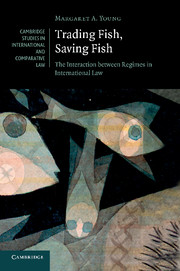Book contents
- Frontmatter
- Contents
- Foreword
- Acknowledgements
- Table of cases
- Table of Conventions, Declarations and procedures
- List of abbreviations
- Part I Trading Fish, Saving Fish
- Part II Selected Case Studies
- Part III Towards Regime Interaction
- Chapter 6 From fragmentation to regime interaction
- Chapter 7 A legal framework for regime interaction
- Chapter 8 Implications for international law
- Appendices
- Bibliography
- Index
- CAMBRIDGE STUDIES IN INTERNATIONAL AND COMPARATIVE LAW
- References
Chapter 7 - A legal framework for regime interaction
Published online by Cambridge University Press: 28 April 2011
- Frontmatter
- Contents
- Foreword
- Acknowledgements
- Table of cases
- Table of Conventions, Declarations and procedures
- List of abbreviations
- Part I Trading Fish, Saving Fish
- Part II Selected Case Studies
- Part III Towards Regime Interaction
- Chapter 6 From fragmentation to regime interaction
- Chapter 7 A legal framework for regime interaction
- Chapter 8 Implications for international law
- Appendices
- Bibliography
- Index
- CAMBRIDGE STUDIES IN INTERNATIONAL AND COMPARATIVE LAW
- References
Summary
As more and more of the responsibility of the national public realms is exteriorised and communalised in what we may call international intergovernment, the more urgent becomes the problem of its theoretical justification.
This chapter develops a legal framework for regime interaction. It first points to the various ways in which regime interaction proceeds, whether based on the intent of the same states parties to the relevant regimes, or something else. Where regime interaction is not based on the consent of member states, questions of legitimacy become more important, and the chapter investigates the link between sovereignty of states and the behaviour of international organisations. Such an approach falls short of proposing a form of constitutionalism, but instead engages in principles of international institutional law, including implied powers, to ascertain the capacities and limits of modern international organisations in addressing global problems in a fragmented legal order.
A The multiple bases of regime interaction
The book's investigation into numerous examples of regime interaction demonstrates that there is no single basis on which such interaction occurs. Instead, there are multiple bases for regime interaction. The strictest conception requires all member states of each regime to have adopted mutual norms before they can have influence (‘parallel membership’). One example is the complaint by a non-UN member against the FAO involvement in WTO fisheries subsidies disciplines.
- Type
- Chapter
- Information
- Trading Fish, Saving FishThe Interaction between Regimes in International Law, pp. 267 - 287Publisher: Cambridge University PressPrint publication year: 2011



